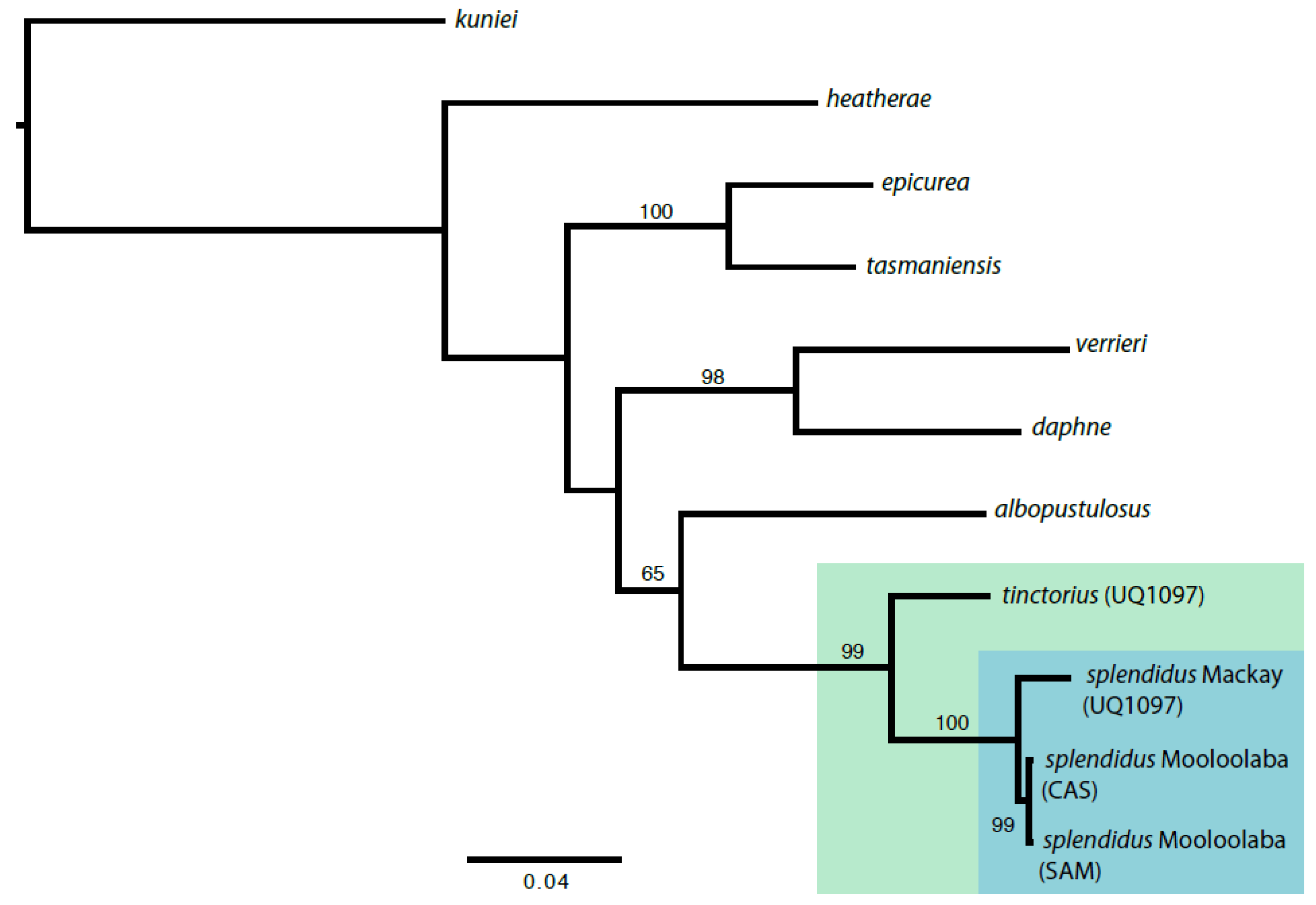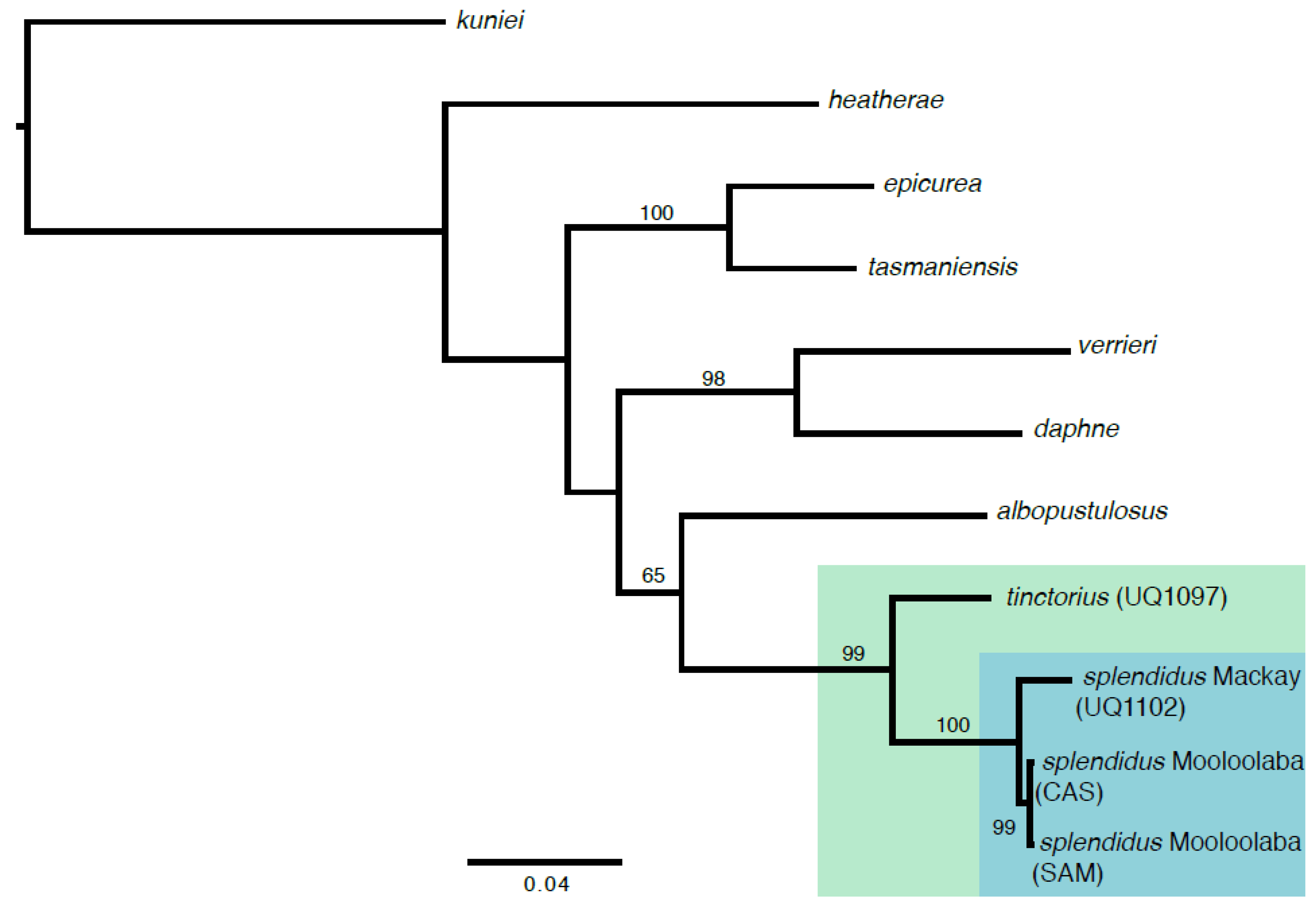Correction: Wilson, N.G., et al. Tropical Range Extension for the Temperate, Endemic South-Eastern Australian Nudibranch Goniobranchus splendidus (Angas, 1864). Diversity 2016, 8, 16
| Species | Voucher | Locality | COI | 16 S |
|---|---|---|---|---|
| G. albopustulosus | CASIZ 142953 | Maui, Hawaii | JQ 727828 | JQ 727701 |
| G. daphne | UQ collection | Gold Coast Seaway, QLD | KJ 001297 | KJ 018921 |
| G. epicurea | SAM D 19285 | Tasmania, Australia | EF 535114 | AY 458804 |
| G. heatherae | CASIZ 175546 | Cape Peninsula, South Africa | JQ 727844 | JQ 727720 |
| G. kuniei | SAM D 19261 | Heron Is., GBR, QLD | EF 535112 | AY 458807 |
| G. splendidus | SAM D 19292 | Mooloolaba, QLD | EF 535115 | AY 458815 |
| G. splendidus | CASIZ 146039 | Mooloolaba, QLD | EU 982738 | EU 982789 |
| G. cf. splendidus | UQ 1102 | Mackay, QLD | pending | pending |
| G. tasmaniensis | SAM 19295 | Triabunna, Tasmania | EF 535113 | AY 458817 |
| G. tinctorius | UQ 1097 | Mackay, QLD | pending | pending |
| G. verrieri | CASIZ 158796 | Batangas, Philippines | JQ 727858 | JQ 727740 |
| Species | Voucher | Locality | COI | 16 S |
|---|---|---|---|---|
| G. albopustulosus | CASIZ 142953 | Maui, Hawaii | JQ 727828 | JQ 727701 |
| G. daphne | UQ collection | Gold Coast Seaway, QLD | KJ 001297 | KJ 018921 |
| G. epicurea | SAM D 19285 | Tasmania, Australia | EF 535114 | AY 458804 |
| G. heatherae | CASIZ 175546 | Cape Peninsula, South Africa | JQ 727844 | JQ 727720 |
| G. kuniei | SAM D 19261 | Heron Is., GBR, QLD | EF 535112 | AY 458807 |
| G. splendidus | SAM D 19292 | Mooloolaba, QLD | EF 535115 | AY 458815 |
| G. splendidus | CASIZ 146039 | Mooloolaba, QLD | EU 982738 | EU 982789 |
| G. cf. splendidus | UQ 1102 | Mackay, QLD | MH018011 | MH017998 |
| G. tasmaniensis | SAM 19295 | Triabunna, Tasmania | EF 535113 | AY 458817 |
| G. tinctorius | UQ 1097 | Mackay, QLD | MH018010 | MH01797 |
| G. verrieri | CASIZ 158796 | Batangas, Philippines | JQ 727858 | JQ 727740 |


Reference
- Wilson, N.G.; Winters, A.E.; Cheney, K.L. Tropical Range Extension for the Temperate, Endemic South-Eastern Australian Nudibranch Goniobranchus splendidus (Angas, 1864). Diversity 2016, 8, 16. [Google Scholar] [CrossRef]
© 2018 by the authors. Licensee MDPI, Basel, Switzerland. This article is an open access article distributed under the terms and conditions of the Creative Commons Attribution (CC BY) license (http://creativecommons.org/licenses/by/4.0/).
Share and Cite
Wilson, N.G.; Winters, A.E.; Cheney, K.L. Correction: Wilson, N.G., et al. Tropical Range Extension for the Temperate, Endemic South-Eastern Australian Nudibranch Goniobranchus splendidus (Angas, 1864). Diversity 2016, 8, 16. Diversity 2018, 10, 57. https://doi.org/10.3390/d10030057
Wilson NG, Winters AE, Cheney KL. Correction: Wilson, N.G., et al. Tropical Range Extension for the Temperate, Endemic South-Eastern Australian Nudibranch Goniobranchus splendidus (Angas, 1864). Diversity 2016, 8, 16. Diversity. 2018; 10(3):57. https://doi.org/10.3390/d10030057
Chicago/Turabian StyleWilson, Nerida G., Anne E. Winters, and Karen L. Cheney. 2018. "Correction: Wilson, N.G., et al. Tropical Range Extension for the Temperate, Endemic South-Eastern Australian Nudibranch Goniobranchus splendidus (Angas, 1864). Diversity 2016, 8, 16" Diversity 10, no. 3: 57. https://doi.org/10.3390/d10030057





